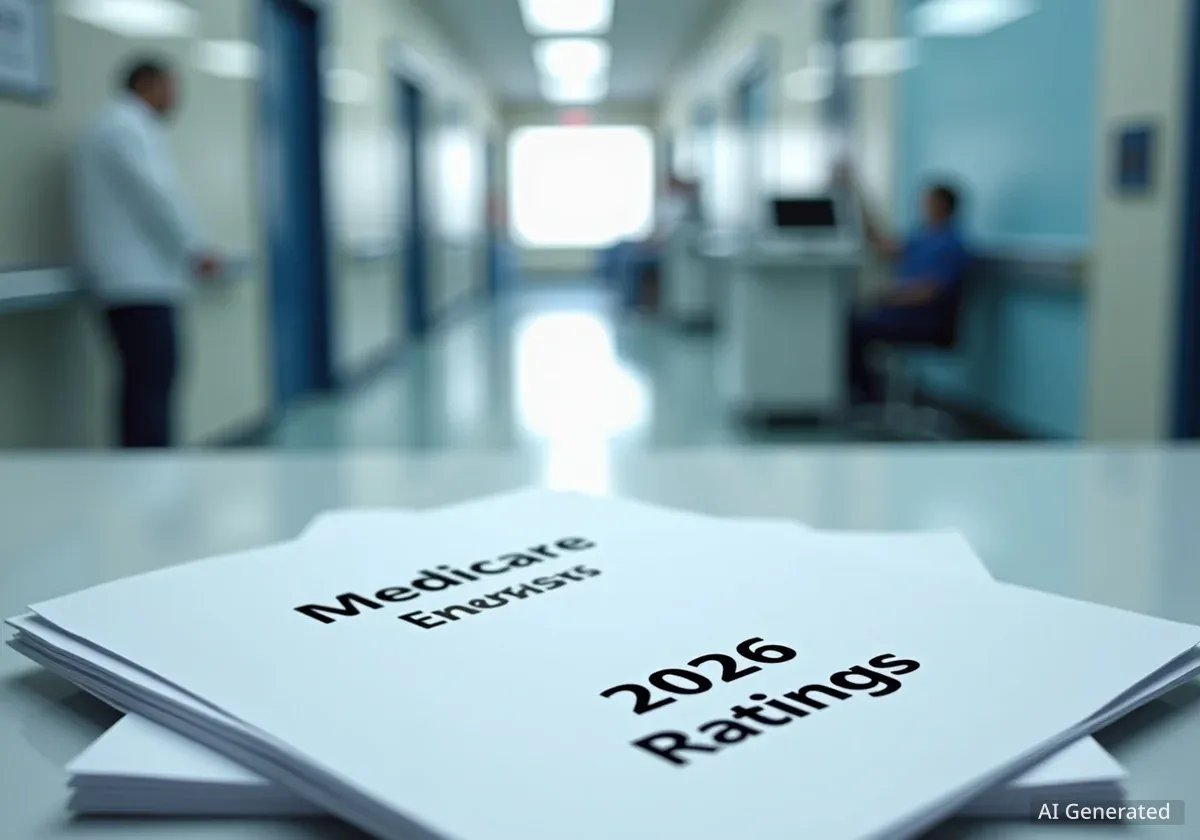The United States government has released its annual quality ratings for 2026 Medicare Advantage and prescription drug plans, a critical assessment that directly influences billions of dollars in bonus payments to health insurance companies. The new ratings reveal strong performance from CVS Health's Aetna unit, while other major insurers like UnitedHealth, Elevance, and Humana showed varied results.
These ratings, known as Star Ratings, are a key factor for insurers' revenue in 2027 and serve as a guide for millions of seniors choosing their health coverage. The data indicates that nearly two-thirds of beneficiaries currently in Medicare Advantage drug plans are enrolled in programs rated four stars or higher.
Key Takeaways
- The U.S. Centers for Medicare & Medicaid Services (CMS) has published the 2026 Star Ratings for Medicare plans.
- These ratings determine the size of government bonus payments to insurers, impacting their 2027 revenue.
- CVS Health's Aetna leads major insurers, with over 81% of its members in plans rated four stars or higher.
- Elevance Health demonstrated significant improvement, increasing its membership in top-rated plans from 40% to 55%.
- Overall, 64% of beneficiaries in Medicare Advantage plans with prescription drug coverage are in plans with four or five stars.
The Importance of the Star Ratings System
The Star Ratings system is the federal government's primary tool for evaluating the quality of Medicare Advantage (Part C) and Prescription Drug (Part D) plans. Administered by the Centers for Medicare & Medicaid Services (CMS), the program assigns a rating from one to five stars, with five representing the highest level of performance.
These ratings are not just a report card; they have significant financial consequences. Plans that achieve a rating of four stars or higher are eligible for substantial bonus payments from the government. These bonuses can amount to hundreds of millions or even billions of dollars for large insurance carriers, which can be used to offer additional benefits to members, such as lower premiums or expanded coverage.
How CMS Calculates Star Ratings
To determine a plan's rating, CMS evaluates its performance across several dozen different measures. These metrics are grouped into several categories, including:
- Staying Healthy: Access to screenings, tests, and vaccines.
- Managing Chronic Conditions: How well the plan helps members manage long-term health issues.
- Member Experience: Ratings of the health plan and its customer service.
- Member Complaints: Issues with the plan and its performance.
- Drug Safety: Accuracy of drug pricing and safety of medication use.
For consumers, the ratings provide a simplified way to compare plans during the annual open enrollment period, helping them select high-quality coverage. The system is designed to promote competition among insurers based on quality rather than just cost.
Performance of Major Health Insurers in 2026 Ratings
The 2026 ratings showed distinct performance levels among the nation's largest health insurance providers. The results, which many companies had already hinted at in prior announcements, were largely in line with analyst expectations.
CVS Health and UnitedHealth Lead the Pack
CVS Health's Aetna division emerged as a top performer. The company reported that more than 81% of its Medicare Advantage members are enrolled in plans that received four stars or higher. Furthermore, CVS noted that over 63% of its Aetna members are in plans rated at an even higher 4.5-star level for the upcoming year.
UnitedHealth Group also demonstrated strong results. According to the company, 78% of its members are in plans with four or more stars. Of that group, 40% are enrolled in 4.5-star plans. These figures confirm the company's previously announced expectations.
Overall Market Snapshot
According to research from Oppenheimer, an estimated 64% of all beneficiaries currently enrolled in Medicare Advantage plans that include prescription drug coverage are in plans rated four or five stars. This indicates a broad availability of high-quality options for seniors nationwide.
Elevance Health Shows Significant Gains
One of the most notable improvements came from Elevance Health. The insurer reported that 55% of its membership is now in plans rated four stars or higher. This marks a substantial increase from the 40% figure reported a year ago, positioning Elevance as one of the biggest gainers in this year's ratings cycle.
Analysts highlighted this upward trend as a positive signal for the company's future revenue and market competitiveness. The improvement suggests a successful focus on enhancing quality metrics over the past year.
Humana and Centene's Results
Humana, a major player in the Medicare Advantage market, reported that approximately 20% of its members are in highly-rated plans. This figure, which translates to about 1.2 million beneficiaries, was consistent with the company's earlier guidance to investors.
Centene Corporation also commented on its performance. Michael Carson, the President and CEO of Wellcare, Centene's Medicare business, expressed satisfaction with the company's progress.
"We're pleased with the continued progress reflected in this year's star ratings. We're focused on building on this momentum, ensuring our members receive high-quality, affordable care and continuing to improve health outcomes in the communities we serve."
While specific percentages were not detailed in the initial report, Carson's statement suggests Centene is on a positive trajectory in improving its plan quality.
Financial Implications and Market Outlook
The release of the 2026 Star Ratings is a critical event for the health insurance industry, as the results directly influence financial outcomes for 2027. The bonus payments tied to these ratings are a significant revenue stream that allows top-performing insurers to enhance their market position.
Insurers with higher ratings can offer more attractive benefits, such as zero-dollar premiums, reduced cost-sharing, and coverage for dental, vision, and hearing services. This creates a competitive advantage, helping them attract and retain members during the annual enrollment period.
According to Oppenheimer analyst Michael Wiederhorn, the overall results did not cause major shifts in market perception. "Overall, the results were not very surprising given the various company pre-announcements over recent weeks," he noted in a research report. This indicates that insurers have become more transparent about their expected performance, allowing investors to adjust their expectations ahead of the official release.
The ability to consistently achieve high Star Ratings is a key indicator of an insurer's operational effectiveness and commitment to member health. As the Medicare Advantage market continues to grow, these quality metrics will remain a central focus for both companies and the consumers they serve.





